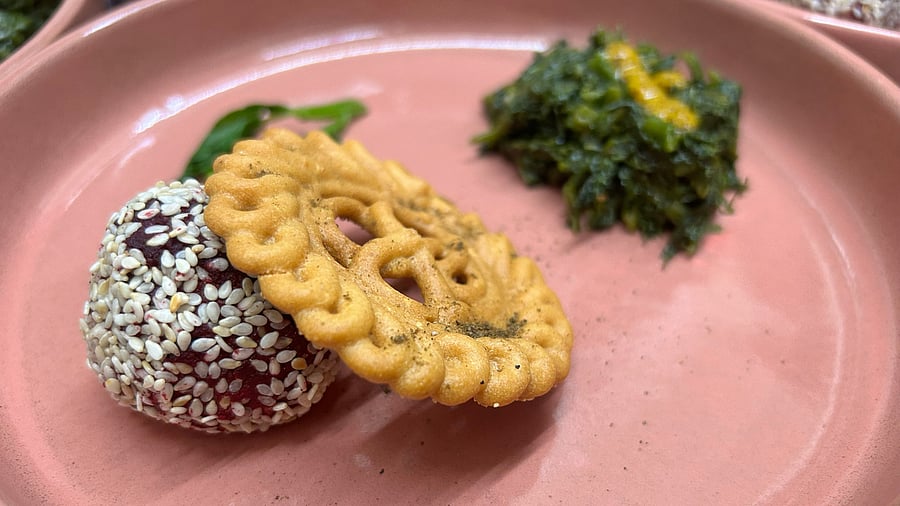
Bengal's famous Goyna bori or jewellery lentil crisp.
Credit: Photo by author
Winter mornings in Kolkata bring honey-gold sunshine that streams through the December crispness. Even the memories of such a morning are redolent with the fragrance of the season’s bounty. Sitting and shelling peas in the sun was a moment of dual delight — the promise of hot koraishutir kochuri (peas-stuffed bread) later and the immediate joy of plundering a few fistfuls of those crunchy globules, their sweetness almost piercing through the vegetal essence.
The call of “Joynogorer Moa” from a passing vendor signified that he had brought a fresh batch of those winter sweets made with date jaggery and khoi (popped rice, as opposed to puffed rice). These treats are made from the Konokchur variety of rice and were granted a Geographical Indication tag in 2015. Winter produce, somehow, always shines brighter, sparkling with extra freshness.
“Winter leafy greens in Kolkata are one of the main reasons to be there during the season. You’ll find a mind-boggling variety of saags: baby spinach with its tendrils and shoots, pea and gram leaves, helencha or buffalo spinach, as well as a range of beautiful winter vegetables like three different varieties of flat beans — one hard, one bright green, and one almost pale white. There’s also pui metuli or Malabar spinach pods, crunchy little seeds, and the baby potatoes of the season. Not to mention winter-specific fruits like oranges, jujube berries, or kuul (elephant wood apples), perfect for pickles,” shares chef and food historian, Pritha Sen.
Just back from her recent pop-up in Jaipur, Pritha Sen highlighted Bengal’s vast repertoire of vegan dishes that truly come alive during winter.
My own childhood food memories revolve around my mother’s famous winter casserole, featuring a whole cauliflower head. As my father’s most beloved vegetable, the occasional flower head of blinding-white cauliflower often made its way to our kitchen from the market. My mother would slather it in her secret spices, toss in some cashews, slivers of onion and tomatoes, and cook it whole in her trusty pressure cooker to create her aromatic, delicious Gobi Musallam. The spiced aroma of that dish filled our home and became one of my favourite childhood memories.
Fresh nolen gur (date palm jaggery) was, of course, a cherished treasure during winters, taking the form of creamy payesh (rice pudding) or simply slipped into a mound of fresh homemade chhana (cottage cheese).
“Dipping anything in nolen gur is a winter indulgence. For me, winter in Kolkata is about the nolen gur that’s in season. We buy it directly from rural Bengal homes near Sonarpur and bring it home to dip our luchis. The sweet and savoury combination sums up winter for me,” says London-based chef and supper club host, Sohini Banerjee.
She recently hosted a pop-up called Kolkatay Thanda, where she curated a meal based on her winter favourites with her own twist. Seasonal delicacies like papadams were served with a side of mashed peas, her take on the winter favourite koraishutir kochuri.
Chef Sohini has also been advocating for zero-waste Bengali food that is seasonal and hyperlocal.
Scoping out the bajars (markets) during winter is a treat for the eyes, a riot of colours. The leafy greens glisten with freshness, and the oranges, carrots, radishes, and beetroots pop with extra vibrancy. Speaking of how so-called exotic vegetables have now become mainstream, Pritha Sen reminds us of the ever-evolving journey of food. Her Komola Dal, for example, is a forgotten dish that made an appearance on her recent pop-up menu. This masoor dal with fresh cauliflower and juicy oranges was creamy with a sudden burst of sweet and sour! “At one time, carrots, tomatoes, and capsicums were exotic and rare, brought in by the Portuguese. But now, they’ve become a part of our everyday food. Similarly, avocados and broccoli will soon become part of our daily cuisine. I’ve already seen broccoli chorchori being made in one of Bengal’s remote villages,” she remarks.
Bengali food is ingredient-driven, sustainable, and makes use of all the varied parts of a vegetable, making it particularly appealing in the winter. Unlike other global cultures, where produce is scarce during the cold months, Bengali produce seems to blossom and come into its own during this time.
“We cook with everything with such valour. We cook with scraps, leftovers, and odds and ends. Our food is rather different from the general global outlook on what Indian food is,” reiterates Sohini, who has been cooking Bengali food for her friends in London.
Apart from the neighbourhood markets, there are online and offline stores like The Bengal Store that celebrate seasonal produce and source the purest ingredients from farmers’ collectives across Bengal’s districts.
One can find a range of winter goodies, such as orange jam and pickles made of jujube berries and elephant wood apples. Their liquid nolen gur, made with date palm jaggery, is one of the purest.
While you can buy jars of this golden elixir, there are also stores like the popular Balaram Mallick Radharam Mallick and Biswa Bangla that sell it in nifty tube-like packaging.
“In Bengal, we eat seasonally. Our food can be sattvik (pure), vegan, and very versatile. It’s important to spread the message of Bengali, ingredient-forward, seasonal eating, as it is part of our culinary legacy,” sums up Pritha Sen.